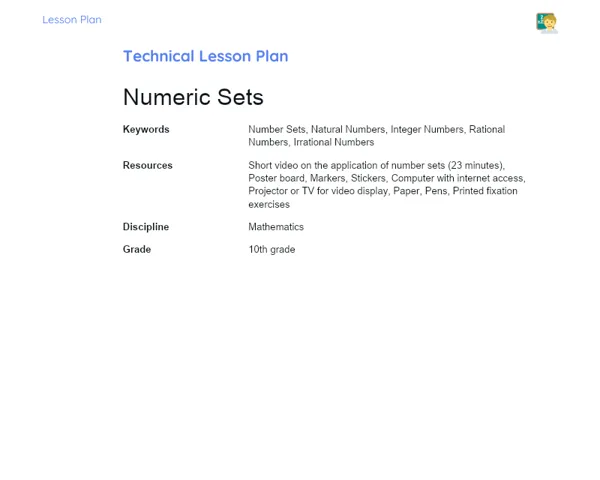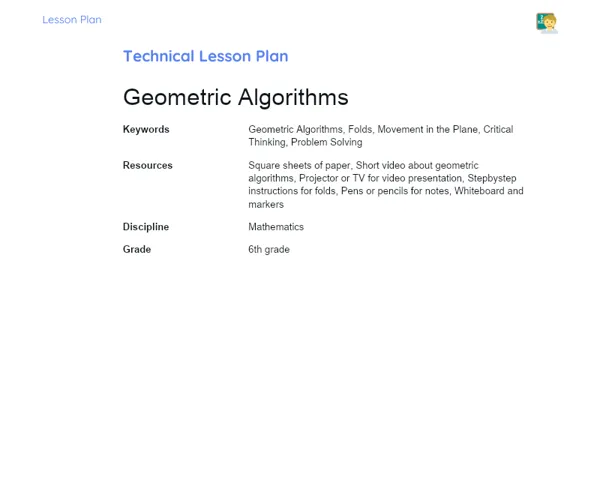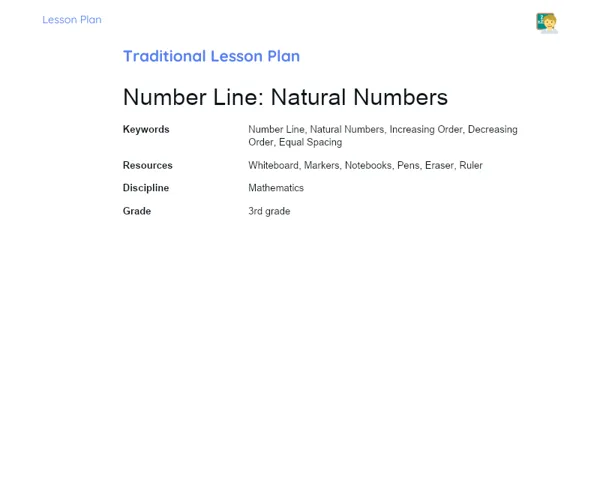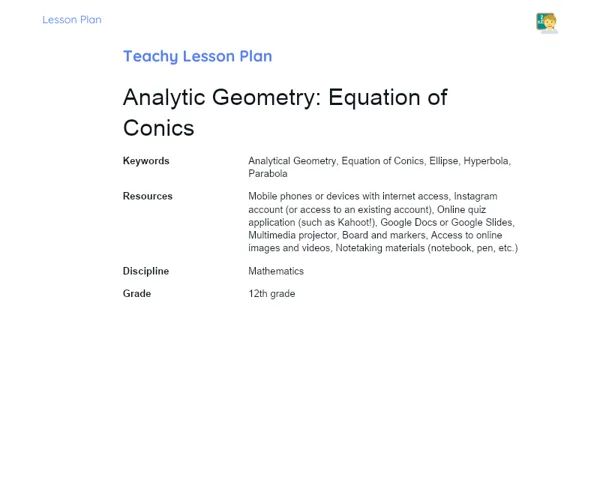Lesson Plan | Lesson Plan Iteratif Teachy | Perimeter
| Keywords | Perimeter, Geometric Shapes, Triangle, Square, Pentagon, Digital Methodology, Active Learning, Practical Activities, Social Media, Graphic Design, Digital Platforms, Practical Applications, Cooperation, Teamwork, Quizzes, Virtual Escape Room, Digital Mapping |
| Resources | Mobile phones, Computers or Tablets, Internet Connectivity, Graphic Design App (e.g., Canva), Digital Sharing Platform (e.g., Google Classroom, Microsoft Teams), Quiz Creation Platform (e.g., Kahoot, Google Forms), Digital Mapping Tools (e.g., Google Maps, CAD Software), Presentation Software (e.g., PowerPoint, Google Slides) |
| Codes | - |
| Grade | 4th grade |
| Discipline | Mathematics |
Goal
Duration: 10 to 15 minutes
The goal of this stage is to clarify and outline the lesson's targets, helping both the teacher and students to focus on the specific skills that need to be developed. This enables a more targeted approach to applying previously learned content, which leads to a more relevant and engaging learning experience.
Goal Utama:
1. Calculate the perimeter of various geometric shapes, such as triangles, squares, and pentagons.
2. Solve real-life problems that require enclosing a specific area or wrapping a gift box.
Goal Sekunder:
- Foster teamwork and collaboration skills through group activities.
- Promote the use of digital tools to tackle mathematical problems.
Introduction
Duration: 10 to 15 minutes
This stage aims to ignite students' interest in the topic while creating an active and collaborative learning space. By digging into interesting facts and discussing key questions, students can connect theoretical knowledge to the real world, warming them up for the practical tasks ahead.
Warming Up
To kick off the lesson on Perimeter, discuss how it's vital for calculating the boundaries of geometric shapes and has everyday uses, like enclosing plots of land or dressing up gift boxes. Ask students to use their phones to uncover an interesting fact about perimeter and present it to the class. This could range from fascinating uses of perimeter in different professions to anything that piques their curiosity.
Initial Thoughts
1. What exactly is perimeter and why is it significant?
2. How can we compute the perimeter of different geometric shapes?
3. Can you recall a time when you had to calculate the perimeter in real life? How did that turn out?
4. How can digital tools aid us in calculating perimeters more effectively?
Development
Duration: 70 to 80 minutes
This stage allows students to apply theoretical concepts of perimeter in real and practical contexts, enriching their learning experience with digital tools. By solving tangible problems, students also build collaboration, creativity, and tech-use skills.
Activity Suggestions
Activity Recommendations
Activity 1 - Perimeter of Digital Influencers 🌟
> Duration: 60 to 70 minutes
- Goal: Apply the concept of perimeter to real-world problems while honing skills in graphic design and digital communication.
- Deskripsi Activity: Students will craft a post on a made-up social media platform where a digital influencer needs to measure the perimeter of various items to style their new studio. Using a graphic design app (like Canva), they'll create posts that explain their perimeter calculations and showcase photos or drawings of the objects.
- Instructions:
-
Split the students into groups of up to 5 members.
-
Each group chooses a fictional digital influencer and decides on which items will be featured in their studio (e.g., frames, tables, rugs).
-
After defining these items, groups calculate the perimeter of each one.
-
Using the graphic design app, each group makes a post for each object, detailing the perimeter calculations and including the visual representation.
-
Share the posts on a school digital platform (Google Classroom, Microsoft Teams) for everyone to view.
Activity 2 - Mathematical Virtual Escape Room ⏳
> Duration: 60 to 70 minutes
- Goal: Encourage logical reasoning and collaboration among students, applying mathematical concepts in a fun, gamified setting.
- Deskripsi Activity: Students will engage in a virtual 'Escape Room' set-up where they must solve puzzles involving perimeter calculations to advance further. They'll utilise a quiz creation platform (like Kahoot or Google Forms) to navigate through a series of challenges until they 'escape'.
- Instructions:
-
Divide the students into groups of up to 5 members.
-
Explain that they will be taking part in a virtual 'Escape Room' game.
-
Provide the link to the quiz set up on the chosen platform.
-
Instruct students to tackle the challenges pertaining to the perimeter of various geometric shapes.
-
Each group submits their answers and unlocks the next stages as they make progress until they escape the room.
Activity 3 - The Park Project 🏞️
> Duration: 60 to 70 minutes
- Goal: Contextualise the study of perimeter within a relevant project while encouraging the use of digital tools for mapping and data representation.
- Deskripsi Activity: Students will design the perimeter of a park using digital mapping tools (like Google Maps or CAD software). They will calculate the perimeter of different park sections (e.g., playground, courts, gardens) and compile a digital report of their findings.
- Instructions:
-
Split the students into groups of up to 5 members.
-
Each group accesses a digital mapping tool and selects a space to plan their park.
-
With their chosen areas defined, students need to work out the perimeter of each section.
-
Using presentation software (like PowerPoint or Google Slides), groups compile a digital report showcasing their calculations and images of the areas.
-
Have the groups share their reports on the school's digital platform for everyone to view.
Feedback
Duration: 20 to 25 minutes
This stage aims to reinforce learning through the exchange of experiences among students, fostering a collaborative and reflective atmosphere. The 360° feedback process develops self-critique and teamwork skills while solidifying their grasp of the concepts covered.
Group Discussion
✨ Group Discussion: Lead a discussion where each group shares what they learned throughout the activities. Use the following framework to kick off the conversation:
- Introduction: Briefly state that the session aims to share learning experiences and conclusions reached by each group.
- Group Presentations: Invite each group to present on one of their activities, outlining their approach and the results.
- Identifying Challenges: Prompt groups to share any challenges they encountered and how they resolved them.
- Use of Digital Tools: Encourage a discussion on how the digital resources used aided their learning process.
- Conclusion: Wrap up by summarising essential points and illustrating how the concept of perimeter has various real-world applications.
Reflections
1. How did the activities enhance your understanding of perimeter? 2. What was the most challenging aspect of the activities, and how did you navigate it? 3. In what ways did digital tools make the calculation of perimeter easier for you?
Feedback 360º
👩🤝👨 360° Feedback: Guide students to conduct a 360° feedback session, allowing each student to receive feedback from their group members regarding their collaboration and contributions during the activities. Encourage constructive and respectful feedback using phrases like:
- 'I appreciated how you...'
- 'It was valuable when you...'
- 'Next time, you might consider...'
Conclusion
Duration: 10 to 15 minutes
📝 Purpose: The aim of this stage is to emphasize the key learnings from our lesson, underlining its significance and relevance in both the world at large and the daily lives of our students. This provides closure by linking learning to their real-life applications and motivating continued use of mathematical concepts.
Summary
🌟 Lesson Summary: Let's recap that perimeter is how we measure the boundary of a geometric figure, whether it’s a triangle, square, or pentagon. We discussed calculating perimeter by adding the lengths of the sides, and we explored this concept in various fun and practical contexts! It became clearer through examples involving digital influencers and our planned parks, right? 😃
World
📱 In the World: In our tech-driven lives, knowing how to calculate perimeter may seem straightforward, yet it’s essential! From crafting layouts for online videos to designing architecture projects using CAD software, perimeter plays a crucial role. Plus, let’s not forget how digital tools simplified our calculations, making everything quicker and more tangible!
Applications
🔧 Applications: Think about measuring the perimeter when putting up a fence in your garden or selecting the best rug for your space—these are just a few real-life examples of how we engage with perimeter without even realising it. It’s a practical skill that makes maths an invaluable tool in day-to-day scenarios.



